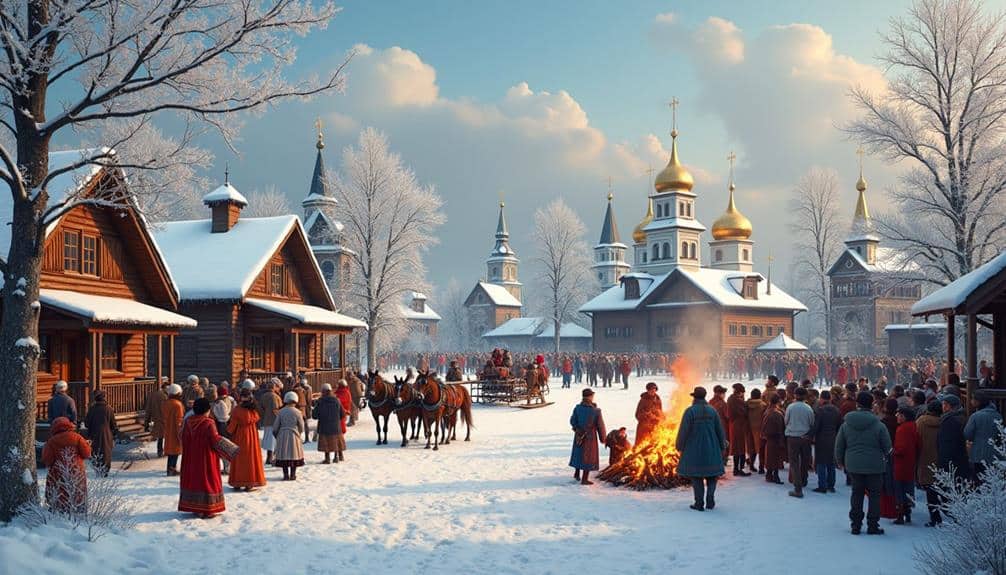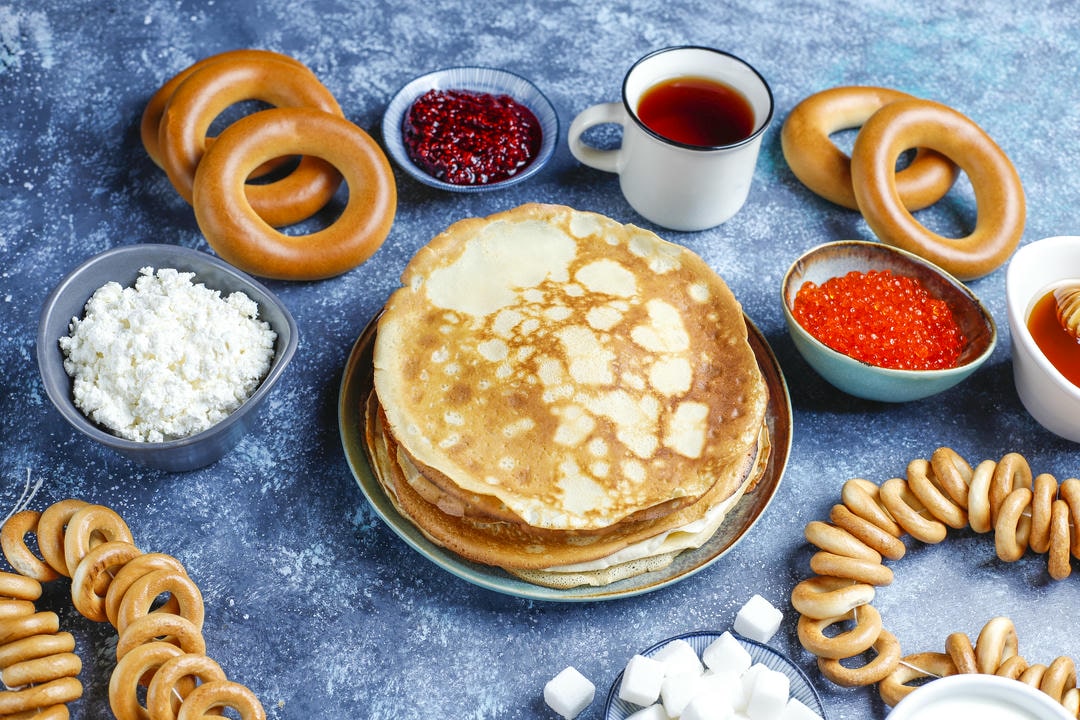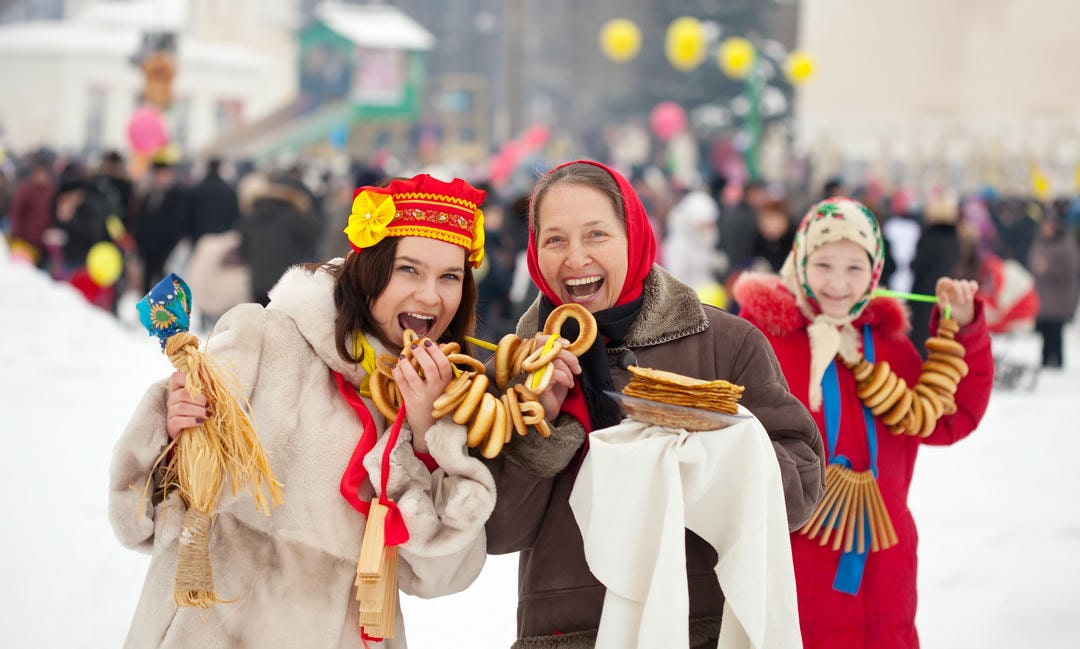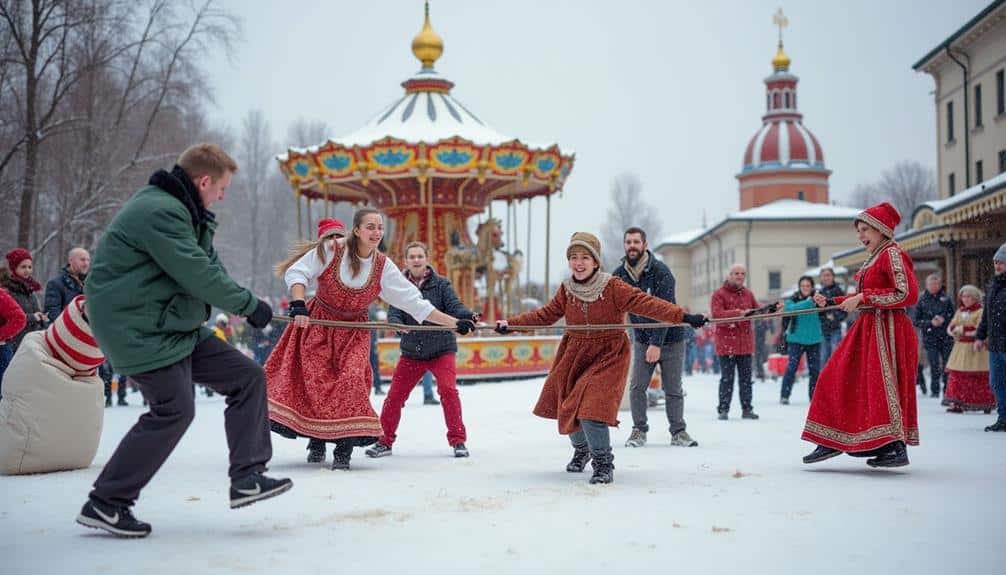When you explore Russia’s Maslenista Festival, you’ll uncover a variety of traditions marking the end of winter and the arrival of spring. This thousand-year-old celebration, often called “Butter Week,” is more than just a feast; it’s a blend of music, dance, and communal games that emphasize unity and resilience. The highlight, of course, is the blini, served with an array of toppings that will tempt your taste buds. Parades featuring elaborate floats and colorful costumes add to the festive atmosphere. But what really binds this event together? Let’s look at how these elements create lasting memories for everyone involved.
History and Origins

Maslenitsa, often referred to as “Butter Week,” has roots that stretch back over a thousand years. You might find it fascinating that this vibrant festival predates Christianity in Russia and celebrates the imminent arrival of spring. At its core, Maslenitsa embodies cultural significance, blending pagan and Christian traditions.
It’s a time when communities come together, shaking off the winter blues and embracing the promise of warmer days. Imagine yourself in a lively town square, where the air buzzes with excitement. Maslenitsa’s seasonal celebrations aren’t just about merrymaking; they’re about reclaiming your sense of freedom after months of cold and darkness.
You’d see people dancing, singing, and participating in various outdoor activities, all symbolizing the triumph of light over darkness. Historically, Maslenitsa served as a farewell to winter and a preparation for the Lenten fast.
It’s a reminder of the cyclical nature of life, where each ending heralds a new beginning. As you explore deeper into the festival’s history, you’ll appreciate how it has adapted over the centuries, yet remains a powerful reflection of human resilience and the enduring joy of communal celebration.
Traditional Foods

What better way to immerse oneself in the heart of Maslenitsa than through its traditional foods? You can’t celebrate this vibrant festival without indulging in blini, those delightful Russian pancakes. Each family has its own blini recipes, passed down through generations, offering a variety of pancake variations.
Whether they’re thin and crispy or thick and fluffy, blini are the star of Maslenitsa. Top your blini with traditional toppings like sour cream, caviar, honey, or jam. These toppings aren’t just delicious; they symbolize the richness and bounty of the season.
Pair your blini with festive beverages like kvass or medovukha, and you’re in for a culinary treat that captures the spirit of the festival. Regional specialties also play a big role. In some areas, you’ll find blini stuffed with mushrooms or meat, showcasing unique cooking techniques.
The diversity in preparation highlights the freedom to explore different flavors and textures.
Music and Dance
The vibrant energy of Maslenitsa truly comes alive through its music and dance. As you wander through the festival grounds, you’ll hear the rhythmic beats of traditional folk music filling the air. Musicians play balalaikas, accordions, and other folk instruments, creating a lively atmosphere that invites everyone to join in the merriment. These sounds aren’t just background noise; they’re the heartbeat of the festival, connecting you to centuries-old folk traditions.
You’ll quickly find that dancing is an essential part of Maslenitsa. People of all ages form circles, holding hands and twirling to the infectious tunes. The dances are often spontaneous, reflecting the festival’s spirit of freedom and joy. It’s a time when everyone can let loose and celebrate the end of winter, welcoming the longer days and warmth of spring.
Participating in these dances, you’ll feel a sense of community and shared history. Each movement, each song, is a nod to seasonal celebrations of the past.
Parades and Costumes

A kaleidoscope of colors and creativity, the parades at Maslenitsa are nothing short of spectacular. As you wander through the vibrant streets, you’ll find yourself captivated by the sheer artistry on display.
Parade floats, elaborately decorated to celebrate the end of winter and the arrival of spring, glide past in a breathtaking procession. Each float tells a story, often featuring mythical creatures, traditional folklore, or scenes from everyday life, all brought to life with meticulous detail.
The real showstoppers, though, are the costumes. Costume design at Maslenitsa is an art form, and participants don outfits that range from historically accurate to wildly imaginative.
Traditional garb, adorned with intricate embroidery and bold patterns, mingles with modern interpretations of classic themes. You’ll see everything from sun gods to mischievous spirits, each costume a reflection of the wearer’s creativity and spirit.
Freedom of expression is at the heart of Maslenitsa, and nowhere is that more evident than in the parade.
Whether you’re admiring the craftsmanship of a parade float or marveling at the ingenuity of a homemade costume, you’ll feel the festival’s joyous, liberating energy infuse every corner of the celebration.
Games and Activities

Step right into the heart of Maslenitsa, and you’ll find an array of games and activities that embody the festival’s lively spirit. Embrace the thrill of outdoor competitions as you join in on tug-of-war matches, sack races, and log climbing. There’s nothing quite like the rush of friendly competition, where everyone’s free to test their strength and agility.
You’ll feel the crisp winter air and hear the laughter of participants echoing through the festival grounds.
But it’s not all about physical prowess. Immerse yourself in the world of traditional crafts, where you can release your creativity. Try your hand at pottery, weaving, or painting Matryoshka dolls. These activities offer a hands-on way to connect with the rich cultural heritage of Maslenitsa.
You’ll find skilled artisans keen to share their knowledge, guiding you through each step with patience and enthusiasm.
Whether you’re scaling a pole or crafting a keepsake, Maslenitsa’s games and activities are a celebration of freedom and joy. Each moment spent here is a reflection of the festival’s vibrant energy, inviting you to break free from the mundane and immerse yourself in the festive spirit.
Community and Family
Maslenitsa’s essence thrives in the bonds of community and family. Picture yourself surrounded by loved ones, sharing laughter and stories as you flip pancakes over an open flame. It’s not just about the food; it’s the pure joy of family bonding. This festival offers a space where generations come together, young and old, strengthening those crucial family ties.
You’ll find that Maslenitsa encourages community togetherness like no other event. Imagine walking through a lively village square, every corner bursting with energy and color. Neighbors who’ve barely exchanged a word all year come together, creating a sense of unity and mutual respect. You’ll feel an undeniable sense of belonging, as if the entire community’s heartbeat syncs with your own.
Think about the freedom in these moments. You’re not just a spectator; you’re an active participant in a living tradition. The walls that usually separate people drop away, replaced by a collective spirit of celebration.
Whether it’s dancing around a bonfire or engaging in friendly competitions, every activity fosters a sense of togetherness that lingers long after the festival ends. In Maslenitsa, you’ll find that community and family aren’t just celebrated—they’re cherished.




